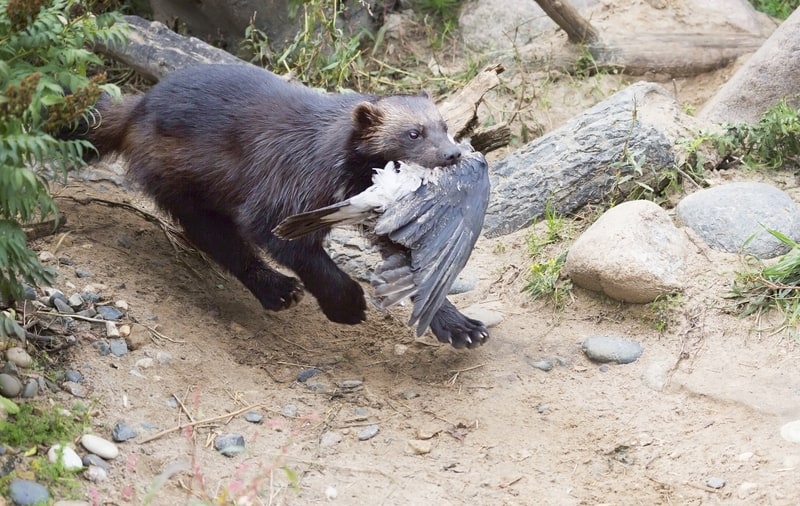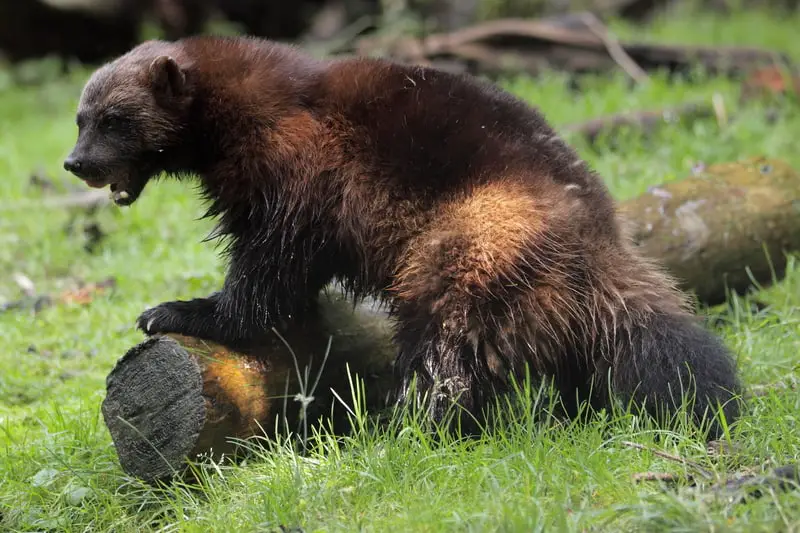(Scientific name of the wolverine- gulo gulo)
A wolverine looks somewhat like a miniature bear. Actually, though, wolverines are the largest member of the weasel family, which lives exclusively on land. They’re a member of the Mustelidae family, which includes weasels, minks, the American badger, the honey badger, and other similar animals. The only mustelids bigger than wolverines are African clawless otters, sea otters, and the Amazon’s giant river otters. All of these are semi-aquatic. The least weasel is the smallest mustelid.
Wolverines are members of the Gulo genus. Gulo is Latin for glutton, giving reference to their huge appetites. They are the only extant members of the Gulo genus. However, the fossil record shows that there were several extinct members of this same genus.
Wolverines are famous for their strength and ferocity. They don’t always win the fight, but when the chips are down, they’re willing to face down almost any animal that gets in their way.
Like all mustelids, wolverines spray a nasty-smelling concoction from their anal glands. This is a rank-smelling yellowish, brown-colored musk. They use it to mark their territory or as a weapon when they’re in a fight. Consequently, one of the nicknames they’ve earned is Skunk Bear.
Wolverine description/characteristics
What do Wolverines look like?
These animals look somewhat like a cross between a small bear and a large badger. Incidentally, wolverines are not related to bears, but they are related to badgers. Both animals are members of the Mustelidae family.
Wolverines have a muscular, stocky build. They have short legs in proportion to their body size. Their five-toed feet are comparatively large, with their front feet being larger than their hinds. On each toe, they have curved, sharp claws that are semi-retractable. They have a bushy tail that is approximately 1/5 as long as their body. Compared to other mustelids, they have a broad, thick skull, small eyes, and short round ears. Their extremely powerful jaws are built for crushing the bones of any of the large animals that they eat, such as caribou and moose.
Wolverines have poor eyesight, but they make up for that by having very good hearing and a keen sense of smell. They can sniff out food that is lying under multiple feet of snow or even underground. Their underground food comes in the form of hibernating prey animals.
Wolverine Fur / Properties / Coloration
Wolverines have tough fur that is extremely oily and water-resistant on top of a thick hide. It also repels frost better than most other furs. Consequently, it is prized by the indigenous people of northern Canada, Alaska, and Siberia as a fringe lining for their gloves and especially parka hoods that insulate in extremely cold weather.
Their coloration is dark brown to almost black. Sometimes but rarely, they are cream-colored with brownish feet. Most individuals have a lighter-colored mask above the eyes and around the face. Additionally, some individuals have white patches on their throat and chest. They also have a pale buff stripe that runs horizontally from their head, down their neck, shoulder, ribcage, and down the length of their bodies and across their rump. This horizontal stripe ranges in color from cream-colored to pale yellow to reddish-brown.
Wolverine Size
People often ask the question, “How Big is a Wolverine?” They are roughly the size of a medium dog. On average, in adult size, wolverines are 13.98 in (35.5cm) to 17.06 in (43.32cm) tall and 35.43 in (90 cm) to 44.29 in (112.5 cm) long. They range in weight from 24 lb (10.9 kg) to 39.9 lb (18.1 kg). Wolverines display significant sexual dimorphism in size. Adult males are sometimes as much as 30% larger than adult females in height and length. Additionally, an average adult male wolverine will be up to two times larger than an average adult female wolverine in weight. Source

Wolverine temperament
Wolverine’s temperament is the stuff of legends. They are tough cunning scavenger/predators that, on occasion, take down prey as large as moose if the animal is stranded in deep snow. However, they’ll forgo attacking such large prey when the odds aren’t working in their favor. The same goes for their dealings with larger predators. An adult wolverine will face off against a grizzly bear if it has to. A lot of its perceived fierceness is bluster, though. If given a choice, a wolverine will sidestep that fight. Bears and wolves kill wolverines sometimes.
What do wolverines eat?
A Wolverine has a voracious appetite. They are opportunistic eaters. Consequently, they quickly adapt to whatever food source is temporarily abundant. Fortunately for them, they have a keen sense of smell that alerts them to whatever food possibilities are available in their environment. Much of the time, that is live prey. However, they will readily feed on carrion from dead animals such as winter killed moose and caribou. They will also kill larger animals such as moose, elk, deer, and caribou if they’re able to ambush them or the animal is stranded in deep snow.

Analysis of the stomach contents of twenty Alaskan wolverines showed that caribou and moose were their most frequently consumed foods. Stomach content analysis in Norway showed that reindeer are their most important food source. On the coast of Alaska, wolverines feed at times on the carcasses of dead walruses, whales, and seals that have been washed on the beach. Wolverines also eat birds, such as ptarmigans and birds’ eggs. Additionally, they eat small animals such as snowshoe hares, porcupines, squirrels, and small rodents such as ground squirrels, mice, and voles. Source
How do wolverines hunt?
It depends on the terrain and available game. In areas with large predators, wolverines base a large percentage of their diet on scavenging wolf and bear kills.
Wolverines are at their greatest advantage when the snow is deep and soft enough that it won’t support the weight of their prey animals. They have proportionately large, snowshoe-like feet that allow them to run on top of the snow in search of food. In conditions like this, they can run down and kill large ungulates. They kill them by leaping on their back and biting through their spine or crushing their larynx with their powerful jaws.
Wolverines also stalk and kill birds, snowshoe hares, and other small mammals. They also dig into beaver lodges to get at beavers.
Wolverine predators
After reading the long list of things wolverines eat, you might be asking yourself the question, “What eats wolverines?” Wolverines are sometimes killed by larger predators. Wolves, black bears, brown bears, mountain lions, and even golden eagles are capable of killing a wolverine. This is particularly true if the wolverine is young. However, wolves and bears are mainly the animals that kill and consume wolverines. Additionally, humans trap them for their fur.
Wolves are the main natural predators that actively seek out and kill wolverines. The only way a wolverine can escape a pack of wolves is to climb a tree.
If a bear kills a wolverine, it’s usually incidental to quarreling over a dead carcass. A good share of a wolverine’s diet consists of carrion from wolf and bear kills. Sometimes this gets the wolverine in trouble. If a bear and a wolverine cross paths, the wolverine will face the bear down. Sometimes the bear will back off, but sometimes it will kill the wolverine.
More than any of the predators that we’ve discussed, the biggest threat to wolverines is habitat loss. Individual wolverines require hundreds of square miles of undisturbed habitat in the mountainous regions of North America, northern Europe, and Asia.
Wolverine habitat
Most wolverines live in the cold temperate, boreal forests of the world. These are located just south of the arctic in North America, Siberia, Asia, European Russia, and Scandinavia. They also inhabit sub-alpine and alpine regions above the timberline. In the lower 48 states, good wolverine habitat includes alpine forests, sub-alpine forests, and coniferous forest regions, primarily in the Sierra, Cascade, and the Rocky Mountains. Source
Where do wolverines live?
Wolverines live in North America, Northern Europe, and Asia.
Where do wolverines live in Europe and Asia?
The Eurasian subspecies of wolverine lives in Sweden, Norway, Finland, Russia, China, and Mongolia. Source
Where do wolverines live in Canada?
In Canada, they live from Newfoundland west to British Columbia.
Where do wolverines live in the U.S.?
The main population of wolverines in the United States is in Alaska. There are also smaller wolverine populations in the contiguous United States. Washington, Oregon, California, Idaho, Montana, and Wyoming all have small wolverine populations. There are also sporadic reports of wolverine sightings in Utah, Colorado, and Michigan.
Speaking of Utah, from a March 14th, 2022, article in KSLNews.com, biologists from the Utah Division of Wildlife Resources captured a wolverine that was recently responsible for killing or wounding 18 sheep on a farm in Utah’s Rich County. They caught the animal in a barrel trap, which they baited with remains from the dead sheep. UDWR biologists sedated it and then fitted it with a GPS collar. The 28-pound male wolverine was then released on the north slope of the Uinta mountains.
Wolverine life cycle
The majority of the time, wolverines are solitary animals. In any of the ranges that they inhabit, they have a very low population density and a low reproductive rate. These animals use very large home ranges. Male wolverines use territories that take in 270 to 380 square miles (700 to 1,000 square kilometers). They scent mark their territory boundaries and are intolerant of encroachment from other males. However, their territories may overlap the territories of several female wolverines. Incidentally, female wolverine territories, on average, take in 115 to 230 square miles or (300 to 600 square kilometers)
Wolverines are polygamous. Consequently, during their breeding season, which runs from May through August, males will mate with any female that has reached sexual maturity and whose territory intersects with their own.
Delayed implantation
Like most members of the Mustelidae family, wolverines have delayed implantation. After breeding, the fertilized egg develops into an 8-cell blastocyst. However, the actual implantation of the embryo in the female wolverine’s uterus won’t take place until late fall or early winter. Delayed implantation allows the female to become pregnant when she is in the best possible physical condition. In years when food is scarce, some female wolverines do not become pregnant at all, even though they have successfully mated.
Gestation and birth
Following implantation, a wolverine’s gestation period lasts 30 to 50 days. Females give birth to a litter that contains 2 to 3 kits on average sometime in the late winter or early spring. Their birthing den is generally a snow cave that they have excavated.
Wolverine kits weigh around 3 ounces, (85.0 grams), and are around 4.75 inches (121.0 mm) long. They are born fully furred. However, their first fur is white.
Growth and development
Young wolverines are weaned when they are 9 to 10 weeks old. Subsequently, they begin to travel with their mothers sometime in the early summer of their first year. They will be nearly fully grown and able to find their own food by September of their first year. However, they’ll remain in their natal home range until they’re at least a year old.
Wolverines reach sexual maturity at two years of age. However, most females will not breed in their second year.
The life expectancy for wolverines is 15 to 17 years.
Related Posts:
American Pine Marten – Krebs Creek
All About Fisher Cats – Krebs Creek
The Characteristics of Fisher Cats and Pine Martens – Krebs Creek
Recent Posts
The only venomous snakes in Washington State are Northern Pacific Rattlesnakes. The Northern Pacific Rattlesnake (Crotalus oreganus oreganus) is a sub-species of the Western Rattlesnake. Anyone...
Skunks are not classified as true hibernators. But they go into a state of torpor when the weather gets cold. Skunks are light sleep hibernators, along with opossums, bears, and raccoons. ...

